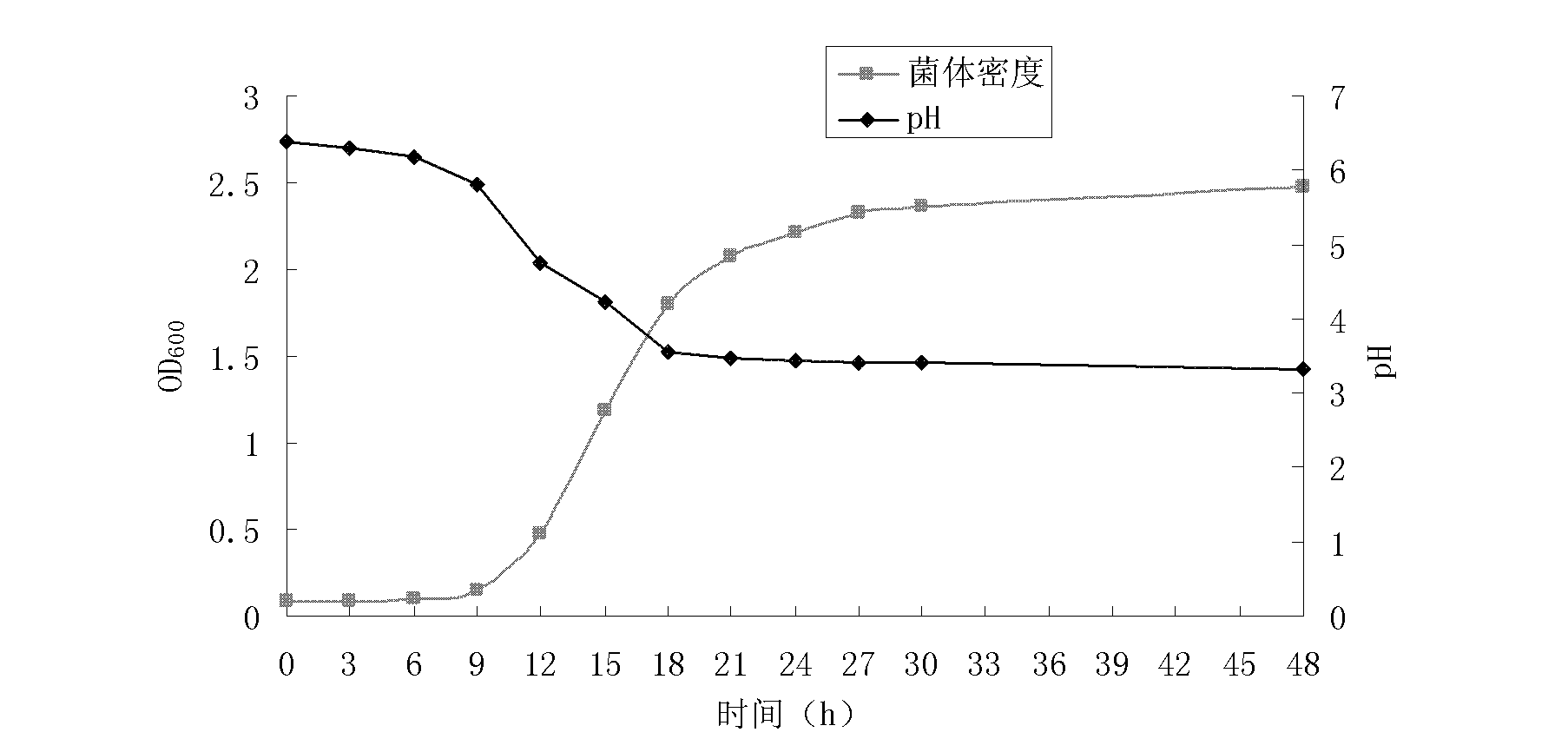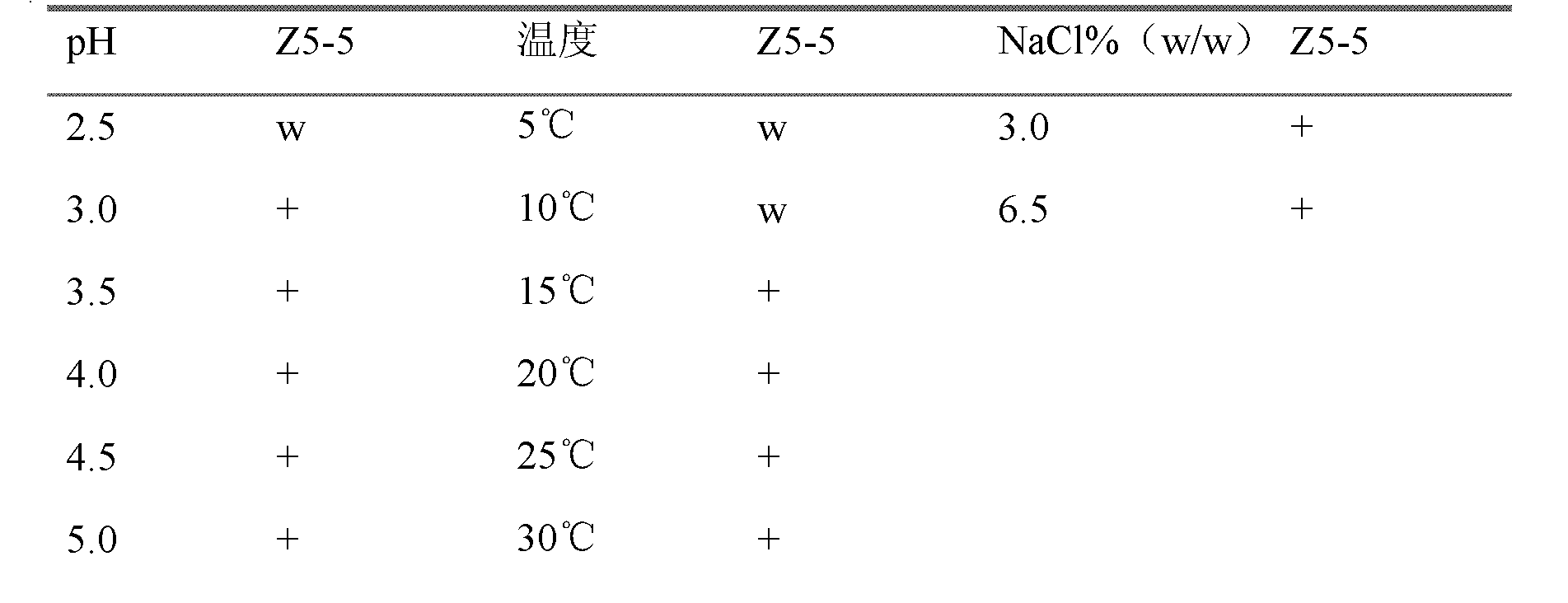Lactobacillus plantarum and its application in the outer leaves of fermented Chinese cabbage
A technology of Lactobacillus plantarum and outsourcing leaves, applied in the directions of application, microorganism-based method, bacteria, etc., can solve the problems of large quantity, perishable, wasteful, difficult to store, etc., and achieves high fermentation efficiency, improved nutritional value, and low cost. Effect
- Summary
- Abstract
- Description
- Claims
- Application Information
AI Technical Summary
Problems solved by technology
Method used
Image
Examples
Embodiment 1
[0028] Example 1. Isolation, purification and identification of Lactobacillus plantarum (Lactobacillus plantarum) Z5-5CGMCC No.5028
[0029] Take 5 mL of homemade pickle juice in Zhengzhou, Henan, add 45 mL of distilled water, shake with a shaker for 5 min, and dilute in a gradient of 10-1-10-5. Take 20 μL from each gradient and spread it on the MRS medium, let it stand for anaerobic culture for 48 hours, pick single colonies with obvious differences in colony shape, size, color and gloss, and repeatedly streak until pure colonies are obtained. Inoculate the strain in MRS liquid medium and ferment for 24h, centrifuge at 10000rpm for 10min, take the supernatant, measure its pH value, adjust the pH to 3.0 and 6.0 with 1mol / L hydrochloric acid and 1mol / L sodium hydroxide, and use vine Micrococcus luteus, Staphylococcus aureus, Bacillus subtilis, Salmonella enterica, Pseudomonas aeruginosa and Escherichia coli were used as indicators respectively Bacteria were tested by Oxford cu...
Embodiment 2
[0036] Embodiment 2, growth and acid production performance of Lactobacillus plantarum (Lactobacillus plantarum) Z5-5CGMCC No.5028
[0037] Lactobacillus plantarum (Lactobacillus plantarum) Z5-5CGMCC No.5028 stored at -80°C was inoculated on MRS solid medium and cultured until colonies grew to obtain activated Lactobacillus plantarum (Lactobacillus plantarum) Z5-5CGMCC No.5028. Inoculate activated Lactobacillus plantarum (Lactobacillus plantarum) Z5-5CGMCC No.5028 into MRS liquid medium (peptone 10.0g / L, beef extract 10.0g / L, yeast extract 5.0g / L, diammonium hydrogen citrate 2.0g / L, glucose 20.0g / L, Tween-801.0g / L, sodium acetate 5.0g / L, dipotassium hydrogen phosphate 2.0g / L, magnesium sulfate 0.58g / L, manganese sulfate 0.25g / L), 30 ℃ constant temperature static culture, the initial pH value is 6.5, the pH value in the fermentation broth is measured every 3h, and the light absorption value at 600nm is measured with a spectrophotometer (OD 600 ), draw the growth curve and aci...
Embodiment 3
[0038] Embodiment 3, the growth situation of plant lactobacillus (Lactobacillus plantarum) Z5-5CGMCC No.5028 under different pH values, temperature and salt concentration environmental conditions
[0039] The initial pH value of the MRS liquid medium was adjusted to 2.5, 3.0, 3.5, 4.0, 4.5, 5.0, 5.5, 6.0, 7.0, 8.0, 9.0 with 1mol / L of hydrochloric acid and 1mol / L of sodium hydroxide, respectively. The activated Z5-5 strain CGMCC No.5028 was respectively inoculated in the above-mentioned medium, and cultured at a constant temperature of 30° C. for 24 hours, and the light absorption value at 600 nm (OD600) was measured with a spectrophotometer. The results are shown in Table 2. Z5-5 strain CGMCC No.5028 grows weakly at the initial pH2.5, but grows well at the initial pH3-pH9.
[0040]The activated Z5-5 strain CGMCC No.5028 was inoculated in MRS liquid medium at 5°C, 10°C, 15°C, 20°C, 25°C, 30°C, 35°C, 40°C, 42°C and 50°C, etc. Cultivate at high temperature for 24h, the initial p...
PUM
 Login to View More
Login to View More Abstract
Description
Claims
Application Information
 Login to View More
Login to View More - R&D
- Intellectual Property
- Life Sciences
- Materials
- Tech Scout
- Unparalleled Data Quality
- Higher Quality Content
- 60% Fewer Hallucinations
Browse by: Latest US Patents, China's latest patents, Technical Efficacy Thesaurus, Application Domain, Technology Topic, Popular Technical Reports.
© 2025 PatSnap. All rights reserved.Legal|Privacy policy|Modern Slavery Act Transparency Statement|Sitemap|About US| Contact US: help@patsnap.com



